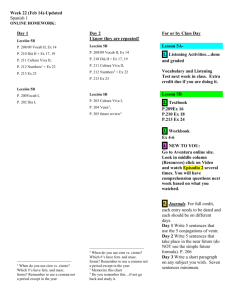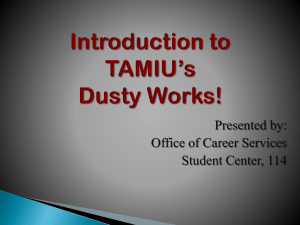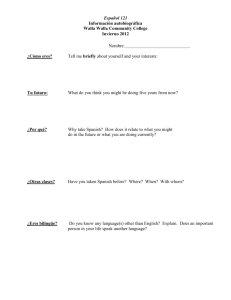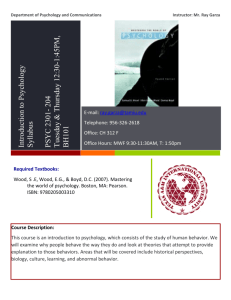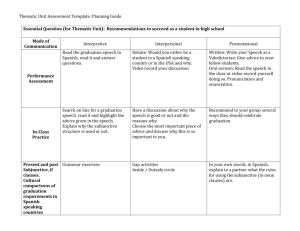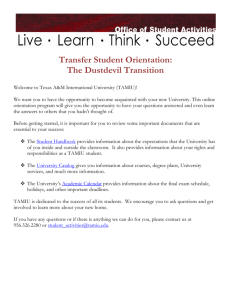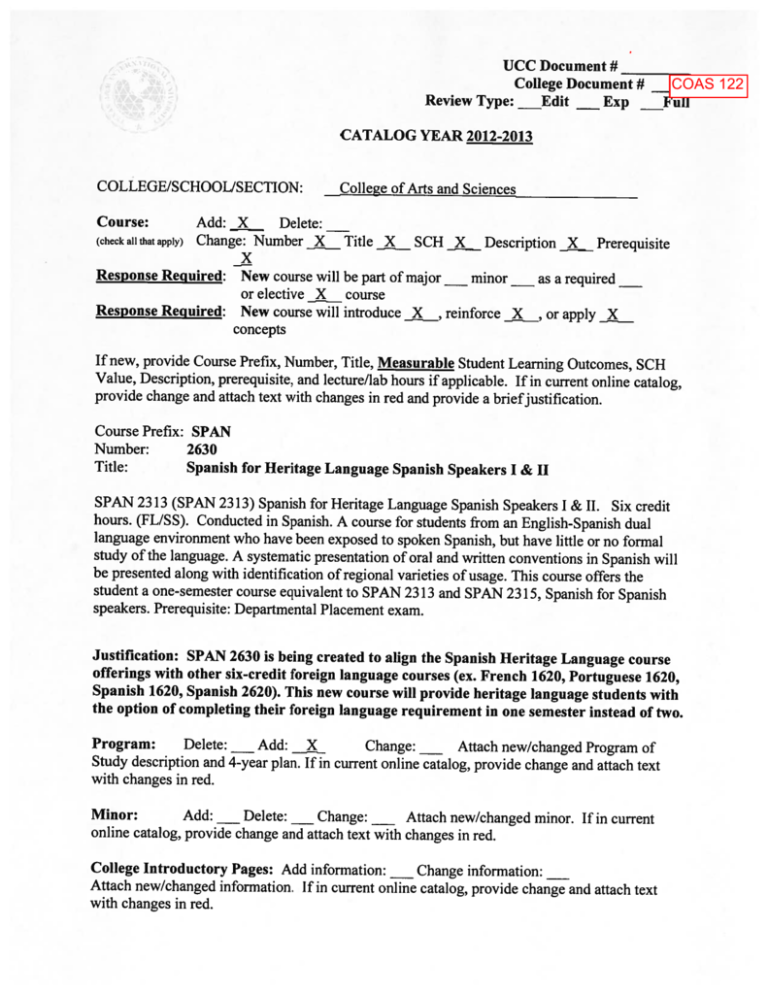
COAS 122
Dr. Agustin Martinez-Samos
Dr. Manuel Broncano
James A Norris
Kevin Lindberg
Digitally signed by Dr. Agustin Martinez-Samos
DN: cn=Dr. Agustin Martinez-Samos, o, ou=Department of
Humanities, email=jmartinez-samos@tamiu.edu, c=US
Date: 2012.02.23 10:35:29 -06'00'
Digitally signed by Dr. Manuel Broncano
DN: cn=Dr. Manuel Broncano, o=Department of Humanities, ou,
email=manuel.broncano@tamiu.edu, c=US
Date: 2012.02.23 10:35:49 -06'00'
Digitally signed by James A Norris
DN: cn=James A Norris, o=Texas A&M International University,
ou=Dept of Social Sciences, email=jnorris@tamiu.edu, c=US
Date: 2012.02.28 18:01:14 -06'00'
Digitally signed by Kevin Lindberg
DN: cn=Kevin Lindberg, o=COAS, ou=COAS Dean's
Office, email=klindberg@tamiu.edu, c=US
Date: 2012.02.29 08:14:46 -06'00'
TEXAS A&M INTERNATIONAL UNIVERSITY
Department of Languages and Literature
SPAN 2630
Spanish for Heritage Language Speakers I & 2
I.
Course materials:
• Alonso-Lyrintizis, D. & Zaslow, B. (2004). Entre mundos: An integrated approach
for the native speaker. Upper Saddle River, NJ: Pearson-Prentice Hall.
ISBN 0-13-183409-6
• Angel Access
II.
Course Description
SPAN 2360- Spanish for Heritage Language Speakers I & II
Course Description: SPAN 2313 (SPAN 2313) Spanish for Heritage Language Spanish
Speakers I & II. Six credit hours. (FL/SS). Conducted in Spanish. A course for students from an
English-Spanish dual language environment who have been exposed to spoken Spanish, but have
little or no formal study of the language. A systematic presentation of oral and written
conventions in Spanish will be presented along with identification of regional varieties of usage.
This course offers the student a one-semester course equivalent to SPAN 2313 and SPAN 2315,
Spanish for Spanish speakers. Prerequisite: Departmental Placement exam.
Textbook: Samaniego, Rojas, Rodriguez, De Alarcón. (2004). Mundo 21, Español para
el siglo 21, Curso intermedio. 4ª edition. Boston: Heinle, 2004. ISBN 978-0-547-171319.
III.
Student Outcomes:
By the end of this course students will be able to
• Communicate effectively using thematic content learned in class
• Distinguish between formal and informal speech production appropriate for different
contexts and domains
• Apply various functions to reading content such as narrating, describing, explaining, and
discussing themed passages.
• Demonstrate a basic knowledge of different national cultures where Spanish is spoken.
• Produce descriptive and narrative as well as formal letter writing, demonstrating effective
use of grammatical structures.
IV. Course Grading Policy:
Partial Exams
20%
Oral Presentations
15%
Journal
15%
Homework (Includes 10 hours language lab) 20%
Attendance and Participation
10%
Final Exam
20%
A.- 90-100
1.
B.- 80-89
C.- 70-79
D.- 60-69
F.- 0-59
Note: This class schedule is
a guideline. The instructor reserves the right to make adjustments to the class
schedule as needed. Students will be informed.
Course Outline
Week
Chapter/Topic/Activity
1&2
Lección 1: Cuna de sueños: Estados Unidos y Puerto Rico
Comunicación: ¡Vamos al cine!
Cultura: Los hispanos en los EE.UU. Desafíos, éxito y esperanza
Puerto Rico: San Juan, Ponce, los alrededores y los ritmos de Puerto
Rico
Gramática: Nouns and Articles
3
Lección 2: Raíces y esperanza: España y México
Comunicación: ¡El arte es todo!
Cultura: España: mucho pasado y más presente
Gramática: Present Indicative: Stem-changing verbs; verbs with spelling changes
and irregular verbs
4
Lección 3: Camino de los incas: Perú, Bolivia y Ecuador
Comunicación: ¡Mantente en forma!
Cultura: Perú: piedra angular de los Andes; Bolivia: La Paz, Sucre, la historia y la
cultura
Ecuador: La línea que une
Gramática: Direct and Indirect Object Pronouns; Gustar and similar
constructions
5&6
Lección 4: Potencias del Cono Sur: chile y Argentina
Comunicación: ¡Ser monolingüe tiene cura!
Cultura: Chile: un largo y variado desafío al futuro; Argentina: dos continentes en
uno
Gramática: Preterite and Imperfect: Completed and Background Actions
7
Lección 5: Aspiraciones y contrastes: Paraguay y Uruguay
8&9
10
11 & 12
13
14
Comunicación: ¡El mestizaje de la palabra!
Cultura: Paraguay: la consolidación del progreso; Uruguay: Montevideo, Punta del
Este, Colonia del Sacramento y Candombe
Gramática: The Infinitive, Present subjunctive Forms and the Use of the
Subjunctive in Main Clauses
Lección 6: La modernidad en desafío: Colombia y Venezuela
Comunicación: Energía, ¿renovable o no?
Cultura: Medellín: el paraíso colombiano recuperado;
Redacción:: ensayo- comparación y contraste
Gramática: Relative Pronouns, Present Subjunctive: Adjective clauses, Present
subjunctive: adverbial clauses.
Lección 7: Al ritmo del Caribe: cuba y la Republica Dominicana
Comunicación: ¡Que bailar es sonar con los pies!
Cultura: La Republica Dominicana: la cuna de América; cuba: la palma ante la
tormenta
Lectura: Micro cuento de Guillermo cabrera Infanta
Gramatica: Possessive Adjectives and Pronouns, Past Participle and Present
Perfect Indicative
Lección 8: Los cimentos de la paz: Guatemala y El Salvador
Comunicación: ¡Derechos y justicia para todos!
Cultura: Guatemala: influencia maya en el siglo XXI
Lectura: Me llamo Rigoberta Menchu y así me nació la conciencia (fragmento) de
Rigoberta Menchu Tum
Gramática: Future: Regular and Irregular Verbs; Conditional: Regular and
Irregular Verbs
Lección 9: Sed del futuro: Nicaragua y Honduras
Comunicación: ¡Viaje al centro de las Américas!
Cultura: Nicaragua: reconstrucción de la armonía; Honduras con esperanzas en el
futuro
Gramatica: Imperfect Subjunctive: main clauses, perfect tenses
Redaccion: Una narración reinventada
Lección 10: Dos mares un destino: Costa Rica y Panamá
Comunicación: ¡La artesanía es arte!
Cultura: Costa Rica: ¿utopía americana?; Panamá: acercando dos océanos
Lectura: La paz no tiene fronteras
Gramatica: sequence of tenses: verbs in the indicative and the subjunctive
Policies of the College of Arts and Sciences
Classroom Behavior
The College of Arts and Sciences encourages classroom discussion and academic debate as an essential intellectual
activity. It is essential that students learn to express and defend their beliefs, but it is also essential that they learn
to listen and respond respectfully to others whose beliefs they may not share. The College will always tolerate
diverse, unorthodox, and unpopular points of view, but it will not tolerate condescending or insulting remarks.
When students verbally abuse or ridicule and intimidate others whose views they do not agree with, they subvert
the free exchange of ideas that should characterize a university classroom. If their actions are deemed by the
professor to be disruptive, they will be subject to appropriate disciplinary action, which may include being
involuntarily withdrawn from the class.
Plagiarism and Cheating
Plagiarism is the presentation of someone else’s work as your own. 1) When you borrow someone else’s facts, ideas,
or opinions and put them entirely in your own words, you must acknowledge that these thoughts are not your
own by immediately citing the source in your paper. Failure to do this is plagiarism. 2) When you also borrow
someone else’s words (short phrases, clauses, or sentences), you must enclose the copied words in quotation
marks as well as citing the source. Failure to do this is plagiarism. 3) When you present someone else’s paper or
exam (stolen, borrowed, or bought) as your own, you have committed a clearly intentional form of intellectual
theft and have put your academic future in jeopardy. This is the worst form of plagiarism.
Here is another explanation from the 2010, sixth edition of the Manual of The American Psychological
Association (APA):
Plagiarism: Researchers do not claim the words and ideas of another as their own; they give credit where credit is
due. Quotations marks should be used to indicate the exact words of another. Each time you paraphrase another
author (i.e., summarize a passage or rearrange the order of a sentence and change some of the words), you need
to credit the source in the text.
The key element of this principle is that authors do not present the work of another as if it were their own
words. This can extend to ideas as well as written words. If authors model a study after one done by someone
else, the originating author should be given credit. If the rationale for a study was suggested in the Discussion
section of someone else's article, the person should be given credit. Given the free exchange of ideas, which is
very important
the health of intellectual discourse, authors may not know where an idea for a study originated. If authors do
know, however, they should acknowledge the source; this includes personal communications. (pp. 15-16)
Consult the Writing Center or a recommended guide to documentation and research such as the Manual of the
APA or the MLA Handbook for Writers of Research Papers for guidance on proper documentation. If you still
have doubts concerning proper documentation, seek advice from your instructor prior to submitting a final
draft.
Use of Work in Two or More Courses: You may not submit work completed in one course for a grade in a second
course unless you receive explicit permission to do so by the instructor of the second course.
Penalties for Plagiarism: Should a faculty member discover that a student has committed plagiarism, the student
should receive a grade of 'F' in that course and the matter will be referred to the Honor Council for possible
disciplinary action. The faculty member, however, may elect to give freshmen and sophomore students a “zero”
for the assignment and to allow them to revise the assignment up to a grade of “F” (50%) if they believe that the
student plagiarized out of ignorance or carelessness and not out of an attempt to deceive in order to earn an
unmerited grade. This option should not be available to juniors, seniors, or graduate students, who cannot
reasonably claim ignorance of documentation rules as an excuse.
Caution: Be very careful what you upload to Turn-it-in or send to your professor for evaluation. Whatever you
upload for evaluation will be considered your final, approved draft. If it is plagiarized, you will be held
responsible. The excuse that “it was only a draft” will not be accepted.
Caution: Also, do not share your electronic files with others. If you do, you are responsible for the possible
consequences. If another student takes your file of a paper and changes the name to his or her name and submits
it and you also submit the paper, we will hold both of you responsible for plagiarism. It is impossible for us to
know with certainty who wrote the paper and who stole it. And, of course, we cannot know if there was
collusion between you and the other student in the matter.
Penalties for Cheating: Should a faculty member discover a student cheating on an exam or quiz or other class
project, the student should receive a “zero” for the assignment and not be allowed to make the assignment up.
The incident should be reported to the chair of the department and to the Honor Council. If the cheating is
extensive, however, or if the assignment constitutes a major grade for the course (e.g., a final exam), or if the
student has cheated in the past, the student should receive an “F” in the course, and the matter should be referred
to the Honor Council. Under no circumstances should a student who deserves an “F” in the course be allowed to
withdraw from the course with a “W.”
Student Right of Appeal: Faculty will notify students immediately via the student’s TAMIU e-mail account that
they have submitted plagiarized work. Students have the right to appeal a faculty member’s charge of academic
dishonesty by notifying the TAMIU Honor Council of their intent to appeal as long as the notification of appeal
comes within 5 business days of the faculty member’s e-mail message to the student. The Student Handbook
provides details
UConnect, TAMIU E-Mail, and Dusty Alert
Personal Announcements sent to students through TAMIU’s UConnect Portal and TAMIU E-mail are the
official means of communicating course and university business with students and faculty – not the U.S. Mail
and not other e-mail addresses. Students and faculty must check UConnect and their TAMIU e-mail accounts
regularly, if not daily. Not having seen an important TAMIU e-mail or UConnect message from a faculty
member, chair, or dean is not accepted as an excuse for failure to take important action. Students, faculty, and
staff are encouraged to sign-up for Dusty Alert (see www.tamiu.edu). Dusty Alert is an instant cell phone textmessaging system allowing the university to communicate immediately with you if there is an on-campus
emergency, something of immediate danger to you, or a campus closing.
Copyright Restrictions
The Copyright Act of 1976 grants to copyright owners the exclusive right to reproduce their works and
distribute copies of their work. Works that receive copyright protection include published works such as a
textbook. Copying a textbook without permission from the owner of the copyright may constitute copyright
infringement. Civil and criminal penalties may be assessed for copyright infringement. Civil penalties include
damages up to $100,000; criminal penalties include a fine up to $250,000 and imprisonment.
Students with Disabilities
Texas A&M International University seeks to provide reasonable accommodations for all qualified persons with
disabilities. This University will adhere to all applicable federal, state, and local laws, regulations and guidelines
with respect to providing reasonable accommodations as required to afford equal education opportunity. It is the
student's responsibility to register with the Director of Student Counseling and to contact the faculty member in
a timely fashion to arrange for suitable accommodations.
Incompletes
Students who are unable to complete a course should withdraw from the course before the final date for
withdrawal and receive a “W.” To qualify for an “incomplete” and thus have the opportunity to complete the
course at a later date, a student must meet the following criteria:
1. The student must have completed 90% of the course work assigned before the final date for withdrawing from
a course with a “W”, and the student must be passing the course;
2. The student cannot complete the course because an accident, an illness, or a traumatic personal or family event
occurred after the final date for withdrawal from a course;
3. The student must sign an “Incomplete Grade Contract” and secure signatures of approval from the professor
and the college dean.
4. The student must agree to complete the missing course work before the end of the next long semester; failure
to meet this deadline will cause the “I” to automatically be converted to a “F”; extensions to this deadline may be
granted by the dean of the college.
This is the general policy regarding the circumstances under which an “incomplete” may be granted, but under
exceptional circumstances, a student may receive an incomplete who does not meet all of the criteria above if the
faculty member, department chair, and dean recommend it.
Student Responsibility for Dropping a Course
It is the responsibility of the STUDENT to drop the course before the final date for withdrawal from a course.
Faculty members, in fact, may not drop a student from a course without getting the approval of their
department chair and dean.
Independent Study Course
Independent Study (IS) courses are offered only under exceptional circumstances. Required courses intended to
build academic skills may not be taken as IS (e.g., clinical supervision and internships). No student will take
more than one IS course per semester. Moreover, IS courses are limited to seniors and graduate students. Summer
IS course must continue through both summer sessions.
Grade Changes & Appeals
Faculty are authorized to change final grades only when they have committed a computational error or an error
in recording a grade, and they must receive the approval of their department chairs and the dean to change the
grade. As part of that approval, they must attach a detailed explanation of the reason for the mistake. Only in
rare cases would another reason be entertained as legitimate for a grade change. A student who is unhappy with
his or her grade on an assignment must discuss the situation with the faculty member teaching the course. If
students believe that they have been graded unfairly, they have the right to appeal the grade using a grade appeal
process in the Student Handbook and the Faculty Handbook.
Final Examination
Final Examination must be comprehensive and must contain a written component. The written component
should comprise at least 20% of the final exam grade. Exceptions to this policy must receive the approval of the
department chair and the dean at the beginning of the semester.

